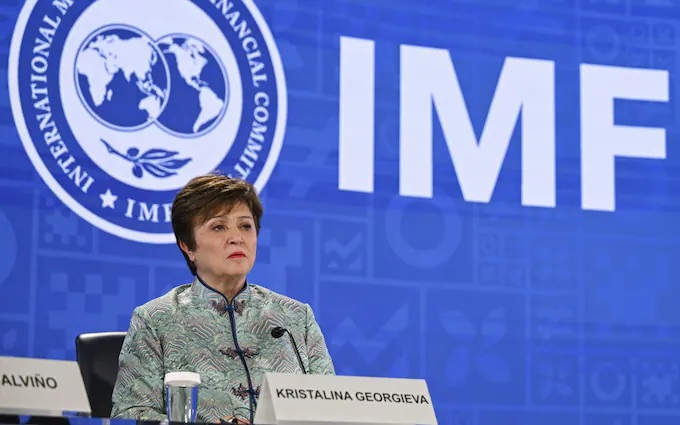Roger Bootle
Much ink has been spilled over the IMF’s recent forecast that the UK economy will be the worst performer among the G7 this year. Yet its forecasting record on such matters is not good. In fact, the really interesting prognostication from the IMF was its suggestion that after the current inflation scare is over, the world will be headed back to a regime of extremely low interest rates. Can this be right?
Interest rates seem to move in large waves as the system shifts from one regime to another. I have lived through several distinct interest rate regimes, starting with low single digit rates in the 1950s and 1960s, through the emergence of double digit rates in the 1970s and 1980s, then the establishment of what seemed like a new normality in the ’90s and early noughties of rates in the 4-7pc range, followed by the long period of near-zero rates from 2008 to 2021, and then the more recent hiking of rates to the 4-5pc range. People tend to believe that the interest rate regime in which they are currently operating is somehow God-given and inevitable. If only.
Everyone operating in financial markets and those of us who are subject to their vagaries should have constantly before us a chart of the history of interest rates. It concentrates the mind. The key is to recognise when one regime is about to give way to another. Policy-makers are currently locked in a battle to reduce inflation and we do not yet know how high rates will have to go to achieve victory. But the really important question is what follows next. That depends upon whether we have fundamentally broken out of the regime that ruled from the aftermath of the Global Financial Crisis (GFC) up until the recent policy tightening. The IMF authors believe that we haven’t. But we first need to understand the forces that underlay that previous regime. If you look at the history of global real interest rates, you see a decided downward trend from about 1990 to the pandemic. Over these years there was an endemic weakness of aggregate demand. Policy-makers countered this weakness with low interest rates, sometimes bolstered by QE, which fed through to lower bond yields.
The $64,000 question is what caused this weakness of aggregate demand. The short answer is that against the backdrop of sluggish real investment by companies, there was an inherent tendency towards high saving. There was an international and a domestic aspect to this story. The international aspect was the emergence of substantial current account imbalances between major countries. Huge persistent surpluses were run by China and a group of other rapidly growing Asian economies, as well as Japan, the oil-producing countries and Germany. The advent of the euro effectively brought the Germanification of much of Europe, such that the euro-zone as a whole became a large surplus area. Within western countries there were also some key domestic influences, especially increased inequality of incomes. Whereas people lower down the income scale tend to spend a high proportion of their incomes, the better off tend to spend proportionately less.
Over and above this, there was a clear demographic influence as a higher proportion of workers moved into the prime saving years of middle age, running up to retirement. The GFC of 2007/9 added two further twists. First, the aftermath involved tighter regulation of banks which inhibited their inclination to lend. Many potential borrowers also felt wary of resorting to the banks for finance. Second, alarmed by the huge rise in their debt ratios, several governments, including ours, tightened fiscal policy. Suffice it to say that hardly anyone in the economic firmament, including the IMF, saw these factors coming. This should make us wary now of accepting a consensus view of the future of interest rates.
Actually, I reckon there are some good reasons why the years to come may not see a return of the previous regime of ultra-low real interest rates. Perhaps the most important factor is demographic. Throughout much of the west and also much of Asia, populations are ageing and in quite a few cases falling. As people move from their late working years into retirement, they move from peak saving into dissaving. This is now going to happen on a significant scale in many countries, including China and much of Europe. Mind you, the danger is that a falling population leads to weaker investment spending, as has happened in Japan. Moreover, as workforces contract, the global bargaining power of labour should increase, thereby making possible a shift in the distribution of incomes towards real wages. To what extent this leads to a narrowing of the distribution of incomes depends partly upon what happens with AI, namely whether it substantially reduces the demand for labour, and especially lower paid labour, and whether it leads to substantial new investment opportunities. Admittedly, not everyone is optimistic on this but I am.
Furthermore, once the world significantly reduces its use of fossil fuels, then the endemic over-saving and huge current account surpluses of the oil-producing countries will end. Suppose that I am wrong. This would spell a return to the recent policy of ultra-low interest rates and QE, as the IMF suggests. Yet given the distortions and risks created by this policy, blithely returning to it would surely be unwise. An alternative would be to try to shore up demand through looser fiscal policy, including substantial amounts of infrastructure investment. Admittedly, in most countries in the west, that option is stymied by the already worryingly high levels of public debt. A third way would be to try to stimulate business investment. Deregulation and radical structural reform of everything from planning systems to the adoption of road pricing schemes, which would revolutionise the market for transport, offers a way forward. Devising such a programme and pushing it through, however, would pose a real challenge for governments.
The Telegraph







